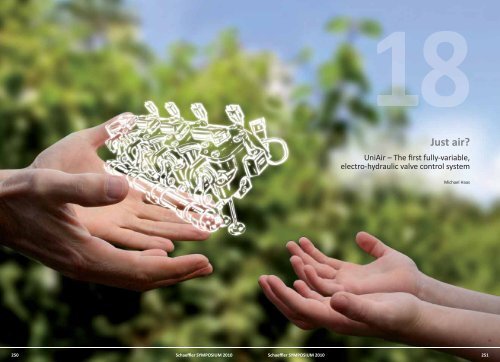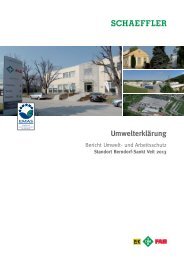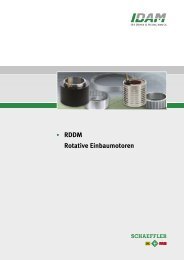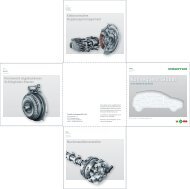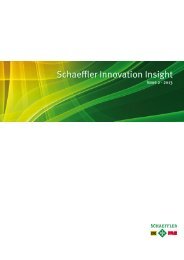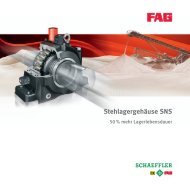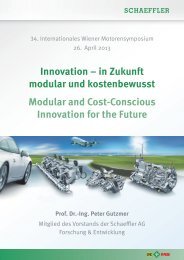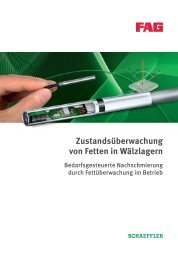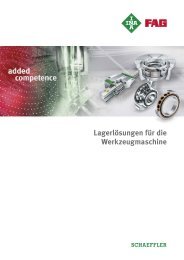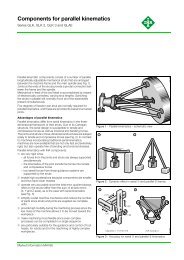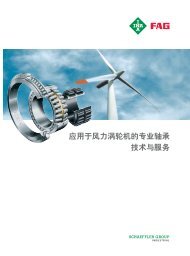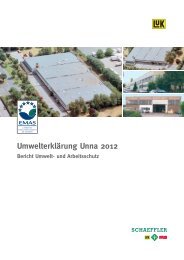18 UniAir - Schaeffler Group
18 UniAir - Schaeffler Group
18 UniAir - Schaeffler Group
You also want an ePaper? Increase the reach of your titles
YUMPU automatically turns print PDFs into web optimized ePapers that Google loves.
<strong>18</strong> <strong>UniAir</strong><br />
<strong>18</strong> <strong>UniAir</strong><br />
250<br />
Schaeffl er SYMPOSIUM 2010<br />
Schaeffl er SYMPOSIUM 2010<br />
251<br />
<strong>UniAir</strong><br />
Just air?<br />
<strong>UniAir</strong> – The fi rst fully-variable,<br />
electro-hydraulic valve control system<br />
Michael Haas<br />
<strong>18</strong><br />
<strong>18</strong>
<strong>18</strong> <strong>UniAir</strong><br />
MEGATRENDS IN THE AUTOMOTIVE INDUSTRY<br />
Reduced CO2 emissions/<br />
fuel consump�on<br />
Emission regula�ons<br />
> Op�miza�on of the internal<br />
combus�on engine<br />
Figure 1 Megatrends in the automoti ve industry<br />
Despite the increasing trend towards the hybridization<br />
and electrification of automotive powertrains<br />
the internal combustion engine will continue<br />
to play a decisive role in the next few<br />
decades. The increasingly strict limits for CO 2<br />
emissions and thus fuel consumption define the<br />
optimization of the internal combustion engine<br />
as the automotive industry’s main task. Along<br />
with electrification,<br />
hybridization and the<br />
development of low<br />
cost vehicles, the optimization<br />
of fuel consumption<br />
has become<br />
a megatrend (Figure<br />
1). One possible<br />
method of meeting<br />
ambitious fuel consumption<br />
and emissions<br />
targets is the<br />
use of variable valve<br />
trains.<br />
The <strong>Schaeffler</strong> <strong>Group</strong><br />
has been working on<br />
the different types of<br />
variable valve trains<br />
for a long time. A distinction<br />
is made be-<br />
Low cost vehicles Electrifica�on/<br />
hybridiza�on<br />
Phase adjustment<br />
Con�nuous<br />
• Hydraulic<br />
• Electromechanical<br />
tween valve train systems with variable phases<br />
and valve trains systems with variable lift. Variable<br />
camshaft phasing units that adjust the<br />
phases can influence exhaust gas recirculation<br />
and the effective compression ratio. Systems<br />
with variable lift can have a discrete two- or<br />
three-step lift actuation or be fully-variable. This<br />
article focuses on fully-variable valve train sys-<br />
Discrete<br />
Figure 2 Variability of the valve train<br />
• Two-step<br />
• Switchable tappet<br />
• Pivot element<br />
• Finger follower<br />
• Shi�ing cam lobe<br />
• Roller tappet<br />
•<br />
Valve train<br />
Three-step<br />
• Finger follower<br />
• Shi�ing cam lobe<br />
Valve li�<br />
Con�nuous<br />
• Electric<br />
• Mechanical<br />
• Valvetronic<br />
• Electrohydraulic<br />
• <strong>UniAir</strong><br />
tems (Figure 2). The <strong>Schaeffler</strong> <strong>Group</strong> soon recognized<br />
that fully-variable mechanical valve<br />
trains such as Valvetronic cannot optimally meet<br />
all challenges in terms of flexibility. The <strong>Schaeffler</strong><br />
<strong>Group</strong> therefore secured the license rights<br />
to “<strong>UniAir</strong>”, potentially today’s most flexible<br />
valve train system, as early as in 2001.<br />
Introducti on<br />
The variable valve train is one of the key technologies<br />
for implementing strategies for low CO 2<br />
emissions. In conventional gasoline engines with<br />
throttle valve control, up to 10 % of the provided<br />
fuel is consumed as energy for pulling air into<br />
the cylinder against the throttling resistance<br />
when the suitable air volume is metered. If a<br />
variable valve train is used, the throttle valve can<br />
remain completely open (or even be omitted),<br />
252 Schaeffl er SYMPOSIUM 2010<br />
Schaeffl er SYMPOSIUM 2010 253<br />
Pressure p in bar<br />
5<br />
1<br />
2<br />
3<br />
TDC Top dead center<br />
1 Intake valve opens<br />
2 Exhaust valve closes<br />
3 Intake valve closes<br />
4 Exhaust valve opens<br />
t<br />
A Control range of cam phaser<br />
B Control range of va<br />
of variable valve train<br />
p Pressure<br />
Figure 3 Process of conti nuous, variable, mechanical valve trains<br />
4<br />
4<br />
<strong>UniAir</strong><br />
and air can be drawn in by the piston without<br />
resistance. The correct air volume for each operating<br />
point is then controlled directly in the intake<br />
ports of the relevant cylinders by means of<br />
a timing and geometric control of the valve<br />
opening operation.<br />
Figure 3 shows that variable valve trains continuously<br />
adjust the valve lift (see B). If variable<br />
camshaft phasing units are used in addition,<br />
the valve lift curves can be moved towards earlier<br />
closing of the intake valve during phasing.<br />
This reduces the pumping work and increases<br />
the effective work of the engine. The engine<br />
then operates in the so-called Miller cycle in<br />
partial load ranges (Figure 4). The Miller process<br />
describes the movement towards early<br />
closing of the intake valve. A comparison of the<br />
PV diagrams of the standard engine and the<br />
variable engine shows that the area indicating<br />
the pumping work is significantly smaller due to<br />
reduced throttling losses. In addition, less air is<br />
PRessure p in bar<br />
1 2 A 3´<br />
TDC<br />
5<br />
1<br />
2 3´<br />
4<br />
3<br />
3<br />
B<br />
<strong>18</strong><br />
<strong>18</strong>
<strong>18</strong> <strong>UniAir</strong><br />
Intake<br />
valve opens<br />
Exhaust<br />
valve<br />
opens<br />
More effec�ve work<br />
Less<br />
pumping work<br />
Exhaust valve closes Intake valve closes<br />
TDC<br />
A<br />
B<br />
Figure 4 Miller process<br />
drawn into the cylinder due to early closing of<br />
the intake valve. As a result, less work is required<br />
for compression and the temperature<br />
remains at a lower level so that the engine can<br />
provide more energy.<br />
Development<br />
INA<br />
EcoValve<br />
Miller process<br />
BMW<br />
Valvetronic II<br />
Presta<br />
DeltaValveControl<br />
Yamaha<br />
CVVT<br />
BDC<br />
Comparison<br />
of systems<br />
Figure 5 shows a selection of systems that have<br />
been developed by automotive manufacturers,<br />
suppliers or engineering service providers. Although<br />
efforts have been made for decades,<br />
the automotive industry has not succeeded in<br />
developing camless, electromagnetic or electro-hydraulic<br />
systems to a level ready for volume<br />
production that offer the highest degree<br />
of freedom in the valve lift. The main problems<br />
continue to be energy consumption, noise<br />
emissions, costs, and ultimately the safety aspect<br />
of incorrect control that can damage the<br />
engine. This is why only electromechanical systems<br />
have been used in volume production.<br />
Compared to camless valve train systems, they<br />
have a simpler and more robust structure but<br />
comprise relatively complex mechanisms and<br />
transmissions that are often combined with<br />
variable camshaft phasing units. The main disadvantages<br />
of such systems are the low level of<br />
variability, slower response times and the circumstance<br />
that individual control of the cylinders<br />
is not possible or highly complicated. With<br />
the <strong>UniAir</strong> technology, the best compromise<br />
between camless systems and electromechani-<br />
Mechanical systems 3D cam Electro-hydraulic<br />
Toyota<br />
Valvema�c<br />
2008<br />
Fully-variable valve train systems<br />
Toyota<br />
Valvema�c<br />
Mahle<br />
VLD<br />
Delphi<br />
VVA<br />
Nissan<br />
VVEL<br />
Mitsubishi<br />
MIVEC<br />
Meta<br />
VVH<br />
Hilite<br />
Univalve<br />
Honda<br />
A-VTEC<br />
Systems in volume produc�on<br />
BMW<br />
Valvetronic II<br />
2001<br />
Figure 5 Comparison of variable valve train systems<br />
Nissan<br />
VVEL<br />
2007/2008<br />
Suzuki<br />
SNVT<br />
INA<br />
3CAM<br />
Fiat<br />
3D CAM<br />
INA<br />
<strong>UniAir</strong><br />
Mul�Air<br />
2009<br />
cal systems has been ready for volume production<br />
since September 2009. It has been introduced<br />
to the market in the Fiat FIRE MultiAir<br />
engine of the Alpha Romeo MITO. In contrast to<br />
other systems on the market, the <strong>UniAir</strong> technology<br />
offers the highest level of variability<br />
combined with low energy requirements, a high<br />
level of safety against malfunctions, and low<br />
system costs.<br />
Functi onal principle<br />
of the <strong>UniAir</strong><br />
system<br />
The system comprises an actuator acti vated by a<br />
camshaft with an integrated fast-acti ng solenoid<br />
valve and valve control soft ware.<br />
High-pressure<br />
chamber<br />
In contrast to conventional electromechanical<br />
valve trains where the cam contour is transferred<br />
to the engine valve via a rigid element<br />
(such as a tappet or finger follower), <strong>UniAir</strong><br />
uses a defined volume of oil that is confined in<br />
the so-called high-pressure chamber. This oil<br />
volume can be varied using a 2/2-way solenoid<br />
valve. When the solenoid valve is closed, the oil<br />
acts as a hydraulically rigid pushrod. When the<br />
solenoid valve is open, the cam and the valve<br />
254 Schaeffl er SYMPOSIUM 2010<br />
Schaeffl er SYMPOSIUM 2010 255<br />
Brake<br />
+ HVA<br />
Solenoid valve<br />
Pressure accumulator<br />
Pump<br />
Finger follower<br />
Camsha�<br />
Figure 6 <strong>UniAir</strong> system - main components<br />
<strong>UniAir</strong><br />
are disconnected. This allows cyclical and individual<br />
setting of the valve lift curves for the relevant<br />
cylinders and intake valves by controlling<br />
the solenoid valves. For example, if the solenoid<br />
valve is opened before the cam has returned<br />
to the base circle, this is called early intake<br />
valve closing (EIVC). Here, the engine valve<br />
spring forces the valve towards “closing”. The<br />
oil is forced out of the high-pressure chamber<br />
to the so-called intermediate pressure chamber<br />
that is connected with a pressure accumulator.<br />
To enable late opening of the intake valve<br />
(LIVO), the solenoid valve is not fed with current<br />
and remains open. The cam forces oil into<br />
the pressure accumulator via the pump piston.<br />
The solenoid valve is closed in good time before<br />
the engine valve opens. This mode and multilift<br />
operations (engine valve is opened twice in<br />
the same cycle) are permitted only at crankshaft<br />
speeds of up to 3000 1/min. Multi-lift is a<br />
combination of early intake valve closing with<br />
another late intake valve opening. When the<br />
solenoid valve is open, the pressure accumulator<br />
feeds the retained oil volume back to the<br />
high-pressure chamber to refill the chamber<br />
and minimize energy losses. During early intake<br />
valve closing, the intake valve always performs<br />
a ballistic flight phase. This ballistic flight phase<br />
is forced by the engine valve spring. Shortly before<br />
the valve reaches the seat, a hydraulic<br />
brake engages and ensures normal, gentle closing<br />
of the valve. Hydraulic valve lash adjustment<br />
(HLA) is also implemented in the system.<br />
Valve lift modes<br />
The <strong>UniAir</strong> technology enables an extremely<br />
high variability of the valve lift. The different<br />
modes assist in meeting the engine’s requirements<br />
in all operating conditions. Full valve lift<br />
is mainly used at maximum engine power. In<br />
this mode, the solenoid valve remains closed<br />
during the entire cam lift phase. The EIVC mode<br />
is used in partial load of the engine. This means<br />
that the solenoid valve is opened early so that<br />
only partial valve lifts are performed and the air<br />
volume fed to the cylinder is adjusted to the<br />
torque curve. If high torques are required, the<br />
intake valve is closed only shortly before the<br />
cam end so as to prevent the drawn air from<br />
<strong>18</strong><br />
<strong>18</strong>
<strong>18</strong> <strong>UniAir</strong><br />
Valve li�<br />
Valve li�<br />
Max. power<br />
Full valve li�<br />
Exhaust Intake<br />
Cranksha� angle<br />
Engine idle<br />
Late intake valve opening (LIVO)<br />
Exhaust Intake<br />
Cranksha� angle<br />
Figure 7 Valve lift modes for the intake side<br />
being forced out and to increase the effectiveness<br />
at lower speeds.<br />
In ranges close to idling, the intake valve remains<br />
closed at the beginning of the cam lift to set the<br />
air quantity in the cylinder and at the same time<br />
generate high air intake speeds and therefore<br />
sufficient turbulence for the mixture preparation.<br />
The intake valve is opened later (LIVO) by<br />
closing the switching valve. At very low speeds<br />
and loads, the two modes are combined, i.e.<br />
EIVC in the first lift and LIVO in the second lift.<br />
This leads to stable combustion and prevents<br />
problems with overexpansion of the air volume<br />
that is limited by closing the intake valve early.<br />
Design<br />
requirements<br />
To ensure the correct mixture in each operati ng<br />
conditi on, the <strong>UniAir</strong> system must be designed<br />
based on the following requirements:<br />
Valve li�<br />
Valve li�<br />
Torque in the lower speed range<br />
Early intake valve closing (EIVC)<br />
Exhaust Intake<br />
Cranksha� angle<br />
Urban cycle<br />
Mul� li�<br />
Exhaust Intake<br />
Cranksha� angle<br />
�� Oil temperature (min. -30 °C, max. 150 °C)<br />
�� Full functi on in the enti re speed range (700 to<br />
7000 1/min)<br />
�� High level of accuracy of the air quanti ty set in<br />
the cylinder<br />
�� High precision and repeatability of the valve lift s<br />
of each individual valve of the enti re engine<br />
�� Ability to respond as fast as possible (during a<br />
camshaft rotati on) to be equipped for transient<br />
operati on<br />
�� Compensation function for specific component<br />
tolerances and changes in environmental<br />
conditions such as temperature or aging of<br />
components<br />
The <strong>UniAir</strong> system was designed with a special<br />
focus on achieving the functional requirements<br />
at the lowest possible costs. The design also<br />
took into account that customers are not willing<br />
to make considerable concessions with regard to<br />
design envelope, additional weight and friction,<br />
despite the system’s numerous advantages. The<br />
Single actua�on per valve Simultaneous actua�on<br />
Simultaneous actua�on<br />
(hydraulic)<br />
(mechanic)<br />
need for an engine oil supply for the system was<br />
also known from the beginning.<br />
Requirements<br />
Pump Pump Pump<br />
Brake with HLA<br />
Various designs have been developed to cover all<br />
types of applicati ons in gasoline/diesel engines on<br />
the intake and exhaust side (Figure 8).<br />
256 Schaeffl er SYMPOSIUM 2010<br />
Schaeffl er SYMPOSIUM 2010 257<br />
Engine valve<br />
Figure 8 Possible principle system architectures<br />
Li� in mm<br />
8<br />
6<br />
4<br />
2<br />
0<br />
360 450 540<br />
Crank angle in°<br />
Measurement<br />
Calcula�on<br />
(AMESim)<br />
Brake<br />
with HLA<br />
Figure 9 Simulated and measured valve lift curves<br />
Hydraulic bridge<br />
HLA HLA<br />
Guide<br />
<strong>UniAir</strong><br />
The individual control of valves offers the highest<br />
level of flexibility. If the valve of a cylinder is<br />
actuated by means of a hydraulic or mechanical<br />
bridge, this slightly restricts the flexibility but<br />
makes the system significantly more cost-effective.<br />
The decision for the best configuration in<br />
terms of the cost-benefit ratio depends on the<br />
specific application and objective.<br />
System development<br />
and design<br />
Brake (no HLA)<br />
Mechanical bridge<br />
During the development phase, the system was<br />
preliminarily designed using state-of-the-art<br />
design, calculation and simulation tools. By<br />
linking powerful programs such as Matlab/<br />
Simulink and AMESim, a comprehensive tool<br />
for numerical simulation was generated that facilitates<br />
systematic analysis. This tool was used<br />
to design the cam contours and to simulate the<br />
valve lift curves of the intake valves. Figure 9<br />
shows a comparison of the simulated group of<br />
curves with the group of curves actually measured.<br />
<strong>18</strong><br />
<strong>18</strong>
<strong>18</strong> <strong>UniAir</strong><br />
<strong>UniAir</strong> components<br />
The solenoid valve as a<br />
high-precision component<br />
Extremely high requirements in terms of accuracy<br />
are placed on the <strong>UniAir</strong> system to ensure<br />
constantly identical valve lifts of the same valve<br />
and for each actuator over the entire cylinder<br />
head. It is crucial that all components ranging<br />
from pump to brake conform to the tolerances.<br />
The solenoid valves as the control elements for<br />
every required lift curve are of central importance<br />
for the overall system. During the design<br />
phase of this new solenoid valve, the developers<br />
were faced with special challenges such as the<br />
required on and off times, the switching time<br />
precision and durability.<br />
System architecture with a “normally open” solenoid<br />
valve requires the solenoid valve to switch<br />
once per rotation of the camshaft and even several<br />
times during multi-lift operation. To ensure<br />
that the high-pressure chamber is full and there-<br />
Control current in A<br />
12<br />
10<br />
8<br />
6<br />
4<br />
2<br />
0<br />
0 100 200 300 400 500 600 700<br />
Cranksha� in °<br />
Current curve of EIVC<br />
Intake valve, full li�<br />
Intake valve, EIVC<br />
Figure 10 Solenoid valve and current curve of the solenoid valve<br />
fore to ensure full lift during the next cycle, the<br />
solenoid valve is opened for a short time after<br />
each cycle to ensure refilling of the chamber. In<br />
the case of multi-lift operation, it must be ensured<br />
that the armature has reached its resting<br />
position again after opening for the first time before<br />
the solenoid valve is activated a second<br />
time. The current for the second lift can only be<br />
fed after the armature has been in the resting<br />
position for approx. 2 milliseconds.<br />
Figure 10 shows the activation curve of the current<br />
for a solenoid valve and the corresponding<br />
engine valve lift curve. The diagram compares<br />
early intake valve closing with the full lift curve.<br />
A special acti vati on strategy was developed for<br />
the solenoid valve current in order to produce a<br />
fast-acti ng solenoid valve with the lowest possible<br />
current requirements. The current profi le comprises<br />
several secti ons. The non acti vated solenoid<br />
valve is fi rst fed with the so called bias current,<br />
which pre-magneti zes the solenoid valve but<br />
does not switch it. In order to ensure a rapid and<br />
precise energizing procedure, increased peak current<br />
is applied at the ti me of switching. The<br />
switching point is determined<br />
by the soft -<br />
8<br />
6<br />
4<br />
2<br />
0<br />
Engine valve li� in mm<br />
ware depending on<br />
the operati ng conditi<br />
on. Aft er the solenoid<br />
valve has been<br />
actuated completely,<br />
the current is reduced<br />
to holding current,<br />
which keeps the solenoid<br />
valve closed. In<br />
turn, the soft ware determines<br />
the point in<br />
ti me at which the current<br />
is completely<br />
switched off , thereby<br />
opening the solenoid<br />
valve again.<br />
The precision of the<br />
opening and closing<br />
angles of the engine<br />
valves is essential for<br />
system function. The<br />
switching time precision<br />
of the solenoid<br />
valve makes a considerable<br />
contribution in<br />
this regard. During the assembly of the solenoid<br />
valve and their subassemblies, various function<br />
values such as flow and switching times are measured<br />
on the assembly line and the assemblies<br />
are adjusted in such a way that the function values<br />
are within the required range. This means<br />
that the manufacturing tolerances of the individual<br />
parts can be compensated by sorting<br />
them accordingly. Despite compensating the tolerances<br />
of the individual components, it is still<br />
necessary to optimize the precision of the<br />
switching times by means of an appropriate<br />
compensation function. This compensation is active<br />
during the entire lifecycle of the product<br />
and therefore also counteracts changes in<br />
switching times caused by aging. This ensures<br />
optimum balancing of the cylinder charge of one<br />
engine during the entire lifecycle.<br />
The solenoid valve carries out around 330 million<br />
switching operations each during the operating<br />
life of the system. This number of switching<br />
cycles at the required precision poses a significant<br />
challenge for the development of the solenoid<br />
valve. This new solenoid valve was developed<br />
from the concept phase to volume<br />
production readiness using the most advanced<br />
design and simulation methods in cooperation<br />
with Continental Automotive Systems. The function<br />
was accurately validated and the solenoid<br />
valve was integrated in the overall system by<br />
means of several function and operating life<br />
258 Schaeffl er SYMPOSIUM 2010<br />
Schaeffl er SYMPOSIUM 2010 259<br />
Valve li� in mm<br />
10<br />
8<br />
6<br />
4<br />
2<br />
0<br />
Valve li�s at 5000 1/min<br />
and 15 °C without compensa�on<br />
360 720<br />
Cranksha� angle in °<br />
Valve li�s (nominal tOff)<br />
Valve li�s (max. tOff)<br />
Valve li�s (min. tOff)<br />
Figure 11 Compensati on of off ti me t off of the solenoid valve<br />
Ven�lhub in mm<br />
10<br />
8<br />
6<br />
4<br />
2<br />
0<br />
Valve li�s at 5000 1/min<br />
and 15 °C with compensa�on<br />
Valve li�s (nominal tOff)<br />
Valve li�s (max. tOff)<br />
Valve li�s (min. tOff)<br />
<strong>UniAir</strong><br />
360 720<br />
Cranksha� angle in °<br />
tests on component test stands, system test<br />
stands and in vehicles.<br />
The solenoid valves are individually controlled<br />
by the control software via corresponding power<br />
stages. The function of the control software<br />
is to implement the modes and opening and<br />
closing angles of the engine valves as defined<br />
by the engine control system. Here, the software<br />
considers various factors that influence<br />
the behavior of the system in order to find the<br />
correct actuation point of the solenoid valve in<br />
each case. It thereby determines the timing of<br />
the engine valves (Figure 12). The main influencing<br />
factors are covered in greater detail in<br />
the component descriptions and the following<br />
section.<br />
First of all, the on and off times of each solenoid<br />
valve must be mentioned here. They are individually<br />
monitored using the current curve during<br />
each switching process for each cylinder and<br />
then readjusted depending on the operating<br />
condition using data maps in the engine control<br />
system. The special challenge in this case is the<br />
detectability of the current curve over the entire<br />
required temperature range and the oil viscosity<br />
associated with it. All solenoid valve components<br />
must be perfectly matched to each other<br />
to ensure this function.<br />
The system architecture and the component geometry<br />
also determine the character of the valve<br />
<strong>18</strong><br />
<strong>18</strong>
<strong>18</strong> <strong>UniAir</strong><br />
Current Li�<br />
EIVC mode LIVO mode<br />
Solenoid<br />
valve<br />
open<br />
Solenoid<br />
valve<br />
closed<br />
lift curve. This includes the brake unit. This unit is a<br />
slave cylinder that converts the hydraulic pressure<br />
into the movement of the engine valve via a hydraulic<br />
valve lash adjustment element. Since the<br />
engine valve is always closed independently of the<br />
cam contour, it is not braked mechanically before it<br />
lands. To prevent excessive closure speeds that can<br />
generate noise and damage the valve, the engine<br />
valve is braked at the end of its ballisti c fl ight phase<br />
by means of hydraulic control geometries in the<br />
brake piston guidance. This in return enables fast<br />
opening speeds as the brake is short-circuited by<br />
means of a special check valve. Designing all these<br />
components in a specifi c manner ensures that the<br />
engine valve is closed in good ti me under cold conditi<br />
ons (-30 °C) and low closure speeds with hot<br />
engine oil.<br />
Figure 13 Temperature sensor<br />
Solenoid<br />
valve<br />
open<br />
Figure 12 Target angle and modes<br />
EIVC<br />
Temperature in °C<br />
Target angles and mode<br />
80.0<br />
70.0<br />
60.0<br />
50.0<br />
40.0<br />
Solenoid<br />
valve<br />
open<br />
LIVO<br />
Solenoid<br />
valve<br />
closed<br />
The valve movements and the brake function in<br />
particular are determined not only by geometric<br />
and architectural influences, but also environmental<br />
and operating parameters such as engine<br />
speed and oil viscosity. The control system also<br />
needs information about these factors in order<br />
to take them into consideration.<br />
It is necessary to monitor the oil viscosity, parti cularly<br />
during cold starts and the subsequent rise in<br />
internal temperature of the system. In this context,<br />
and as the only additi onal sensor for this system,<br />
the temperature sensor (Figure 13) is an important<br />
component. The sensor measures the oil<br />
temperature in real ti me and supplies an important<br />
input for the control unit for determining the<br />
oil viscosity. The temperature measurement sen-<br />
Response �me<br />
Solenoid<br />
valve<br />
open<br />
90 %<br />
100 %<br />
30.0<br />
20.0<br />
0 1.25 2.5<br />
< 1.4 s<br />
3.75 5 6.25 7.5 8.75 10<br />
Measurement period in s<br />
sor already present on the engine for measuring<br />
cooling water and engine oil is not fast enough.<br />
The sensor with a NTC element (negati ve temperature<br />
coeffi cient) is specially calibrated for use at<br />
low temperatures (highest precision at 0 °C) and<br />
has a response ti me (� in water) of a maximum of<br />
90<br />
1.4 seconds.<br />
Ensuring functi on<br />
and quality<br />
After the <strong>UniAir</strong> actuator has been manufactured<br />
and assembled, it has to pass quality tests<br />
to ensure that the system runs error-free in conjunction<br />
with the control software and fulfills<br />
the required function. An end-of-line (EOL) test<br />
stand (Figure 14) that conforms to development<br />
test stands was specially developed for this purpose.<br />
Essential functions such as full lift, late intake<br />
valve opening and early intake valve closing<br />
are tested for defined control angles and speeds<br />
using a special EOL test program. Switching<br />
times are tested especially in the late intake<br />
valve opening mode where precision is extremely<br />
important. The brake unit is also comprehensively<br />
tested. These tests are performed on the<br />
EOL test stand by means of an automated procedure.<br />
Each actuator is firmly located on the test<br />
cylinder head and checked with regard to the required<br />
precision of the opening and closing angles<br />
as well as the maximum lift height.<br />
Figure 14 End-of-line test stand/test criteria<br />
Summary<br />
260 Schaeffl er SYMPOSIUM 2010<br />
Schaeffl er SYMPOSIUM 2010 261<br />
<strong>UniAir</strong><br />
The variability of valve trains is an important aspect<br />
of internal combusti on engine technology of<br />
the future and will assist us in fulfi lling increasingly<br />
strict current and future legal requirements<br />
regarding emissions and fuel consumpti on as well<br />
as customer requirements. The fully-variable<br />
electro-hydraulic valve train system <strong>UniAir</strong> can expand<br />
the potenti al of current variable valve control<br />
mechanisms and makes a considerable contributi<br />
on to opti mizing combusti on processes.<br />
The development of the <strong>UniAir</strong> system with Fiat<br />
means that the Schaeffl er <strong>Group</strong> has succeeded in<br />
launching a new valve train system. This system<br />
provides numerous benefi ts compared with conventi<br />
onal valve trains not only for vehicle manufacturers,<br />
but also for end customers. The world’s<br />
fi rst fully-variable electro-hydraulic valve control<br />
system was launched on the market in September<br />
2009 in the Alfa Romeo MITO (engine: Fire 1.4 l<br />
4 V 135 HP Turbo variant) under the name Multi -<br />
Air. The <strong>UniAir</strong> technology, which has been included<br />
on the intake side, is now also used in the<br />
Punto EVO. Figure 15 shows the measured advantages<br />
for the Alpha Romeo MITO.<br />
Along with the contributi on to increasing performance<br />
and reducing consumpti on, <strong>UniAir</strong> off ers a<br />
wide range of additi onal benefi ts. Due to its highly<br />
fl exible design, the system can meet diverse customer<br />
requirements and be adapted to nearly every type<br />
of engine. The <strong>UniAir</strong> engine is operated using conventi<br />
onal engine oil. The control soft ware, which is<br />
Mode: Test criteria:<br />
Full li� - Flow monitoring (max. li� + closing angle)<br />
- Opening and closing angles at full li�<br />
- Oil flow<br />
EIVC - Brake func�on test (closing speed)<br />
- Closing behavior of solenoid valve<br />
LIVO - Opening behavior of solenoid valve (opening angle)<br />
- Switching �mes of solenoid valve<br />
Valve li� in mm<br />
LIVO LIVO EIVC EIVC<br />
Cranksha� angle in °<br />
<strong>18</strong><br />
<strong>18</strong>
<strong>18</strong> <strong>UniAir</strong><br />
also supplied by Schaeffl<br />
er, is integrated in the<br />
engine control unit.<br />
Schaeffl er considers itself<br />
as a system partner<br />
of the automoti ve industry<br />
and supplies the<br />
complete <strong>UniAir</strong> system<br />
comprising hardware,<br />
soft ware and calibrati on<br />
data set (Figure 16). The<br />
system off ers a clear<br />
benefi t to automoti ve<br />
manufacturers as they<br />
receive a tested module<br />
from one source that<br />
can be easily integrated<br />
in a cylinder head at the<br />
engine plant.<br />
The <strong>UniAir</strong> system has fi rst been implemented<br />
specifi cally on the intake side of gasoline engines.<br />
However, the system is not solely restricted to the<br />
intake side.<br />
<strong>UniAir</strong> is also interesti ng for applicati ons in diesel<br />
engines of passenger cars. This extremely fl exible<br />
system enables strategies such as internal exhaust<br />
gas recirculati on, intake swirl generati on and variability<br />
of the eff ecti ve compression rati o. <strong>UniAir</strong><br />
has already been implemented in prototypes of<br />
diesel engines for passenger cars.<br />
Calibra�on<br />
data set<br />
So�ware<br />
VCM<br />
(Valve Control<br />
Module)<br />
Engine<br />
control<br />
system<br />
- Up to 10 % reduced<br />
CO 2 emissions/<br />
fuel consump�on<br />
- Up to 10 % more power<br />
- Up to 15 % higher torque<br />
in the lower speed range<br />
(Compared to an engine with a<br />
conven�onal valve train without<br />
a camsha� phasing unit)<br />
Figure 15 First volume producti on applicati on of <strong>UniAir</strong> in the FIAT Fire 1.4 l Multi Air<br />
– advantages<br />
ECU Engine<br />
Schaffler delivery scope<br />
Temperature<br />
sensor<br />
Solenoid<br />
valve<br />
Middlepressure<br />
chamber<br />
Figure 16 <strong>UniAir</strong> system operati ng sequence<br />
First developments have been successfully used<br />
in commercial vehicles. <strong>Schaeffler</strong> and ABB have<br />
signed a cooperation agreement for using this<br />
valve train system in large off-highway engines<br />
(in ships, trains and power generation applications).<br />
In order to meet the requirements of future combusti<br />
on methods, for example CAI/HCCI, in terms<br />
of air and exhaust paths, Schaeffl er and its partners<br />
are already working on the relevant systems in advance<br />
development.<br />
Actuator<br />
High-pressure<br />
chamber<br />
Pressure<br />
accumulator<br />
Pump unit<br />
Brake unit<br />
Camsha�<br />
Nockenwelle<br />
262 Schaeffl er SYMPOSIUM 2010<br />
Schaeffl er SYMPOSIUM 2010 263<br />
<strong>UniAir</strong><br />
<strong>18</strong><br />
<strong>18</strong>


